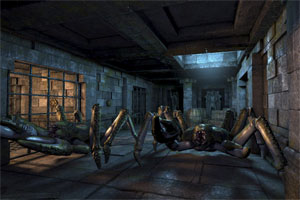
Increasingly, indie games are becoming the jewel of the video game industry. Made by small development teams and often self-published, these games typically feature retro-style graphics and lack the massive amount of voiceover, prerendered cutscenes and other stuff that you’d expect from major publishers like EA or Ubisoft. But they often trump the bigwigs in execution, attention to detail, and flat-out fun. One shining example is Legend of Grimrock, a PC dungeon crawler made by Almost Human Ltd, a four-man Finnish studio.
Grimrock takes us back to the days when PC RPGs were all about exploration and mystery, coupled with robust party management and stat building. The fact that it does so with stunningly beautiful graphics and incredibly fluid monster animations is icing on the cake, since we don’t often see such lush and detailed visuals from games with such low price points ($14.99). The world you’ll explore, an ancient dungeon built into the peak of Grimrock Mountain, is filled with items to pick up, secrets to uncover, weapons to wield, and of course, monsters to tear to pieces. Or vice-versa, more like.
The game world is actually built using a tile-based mapping system, not unlike the classic Wolfenstein 3-D — or, to compare apples to apples, The Legacy: Realm of Terror. Speaking of Legacy, a game that is near and dear to my heart, the comparisons between it and Grimrock are plentiful. Movement is conducted one square at a time, and you can turn in 90-degree increments. Your inventory, stats and spells are all managed through a point-and-click interface, and there are plenty of arcane, mysterious and downright frightening things inhabiting the game world. Grimrock turns the proceedings up a notch from there with the addition of fluid “mouse look” capability, real-time combat and full 3D environments.

Character creation is every bit as robust as you’d expect for a game claiming to be an “old-school” PC RPG. You’ll play with a party of four characters, even though you’ll never actually “see” any of them from your first-person perspective on the game world. You can either choose the default party, or craft your own from scratch using a variety of races, classes and skills. You can even import your own character portraits if you so choose. I went with the default party for my first play through, as the options are truly staggering, but having got a taste of the game now, I would feel more confident in trying my hand at creating a custom party.
The game consists of 15 levels that you experience in turn as you work your way down from the peak of the mountain, with each subsequent level accessed by descending a flight of stairs. The game keeps a handy grid-based map for you, unless you select “Oldschool Mode”, which removes all trace of the automap and even suggests that you get out your grid sheets and draw one yourself! (Little secret: I’m not that hardcore.) At the bottom of the last level resides your freedom — you hope. Getting there in one piece is the real challenge.
I first discovered Legend of Grimrock thanks to near-endless tweets about it from 3D Realms’ own George Broussard, who couldn’t get enough of the game (and wasn’t hesitant to tell everyone about it). After looking into it, I discovered an additional feature that completely sold me on it: the upcoming level editor. Because Grimrock uses a tile-based map system, it’s easy to put together levels with merely a point-and-click interface. Going beyond the simple grids of Wolfenstein 3-D, though, there is also a scripting system that allows you to link objects together and create custom interactions. The editor removes all the fluff and leaves you with a simple system for crafting some truly interesting puzzles, traps and enemy encounters without worrying about non-uniform rational B-splines (or whatever 3D mappers worry about these days). Seriously, check it out:
There was a day when I would buy just about any game that either included or promised a level editor, and I paid far more for some of those craptacular games than the $14.99 that Almost Human is asking. Seriously, if you liked old-school level design, you cannot go wrong with this.
In fact, I particularly liked what Kyle Carpenter of Medium Difficulty had to say about the game, noting that the game’s self-imposed limitations (grid-based map and movement, etc.) actually worked to its advantage, creating a final product that was mindful of its own design decisions and leveraged them to greater effect:
Combining these simple building blocks to make an evocative and thrilling dungeon is nothing less than the lost ancient art of “level design,” long thought dead and replaced by its inferior corrupt cousins “set-piece design” and “scripting”.
As a level designer myself, but one who has not been interested in the craft since games like this fell out of style, I found that remark particularly validating.
Anyone who has a fondness for classic PC RPGs and $14.99 to spare would be well served by picking up a copy of Legend of Grimrock from Steam, Good Old Games, or for an extra dose of indie dev support, direct from Almost Human themselves.
Oddball Verdict: Delightful and Delicious Dungeonry.




